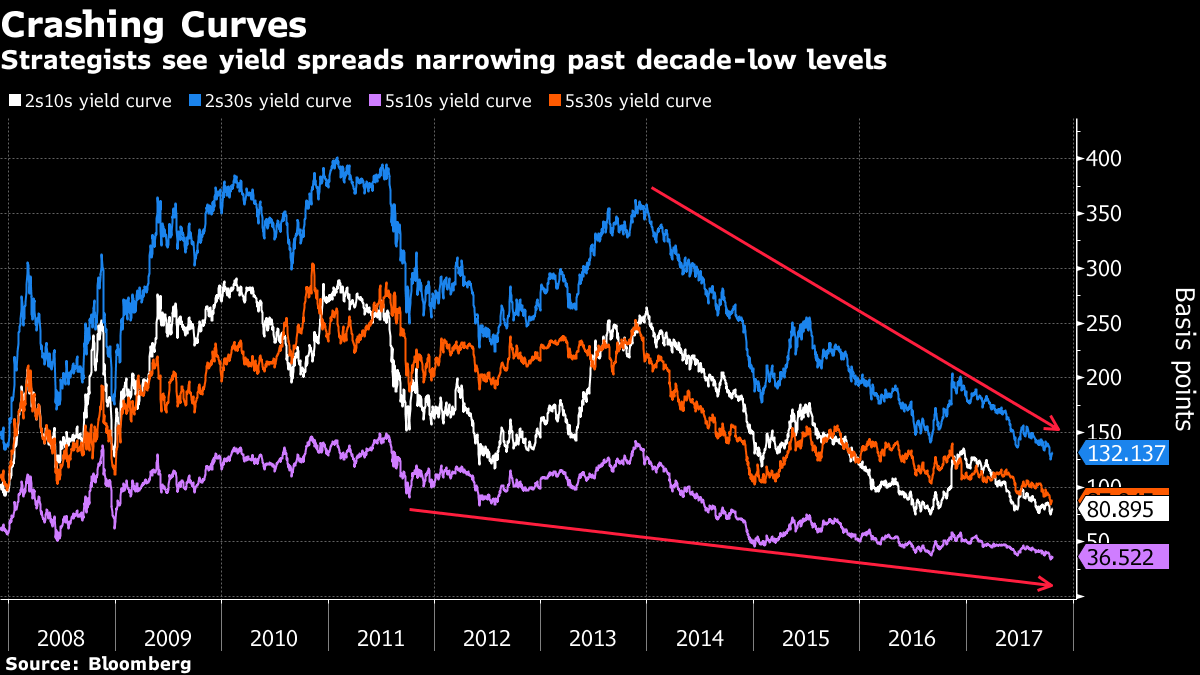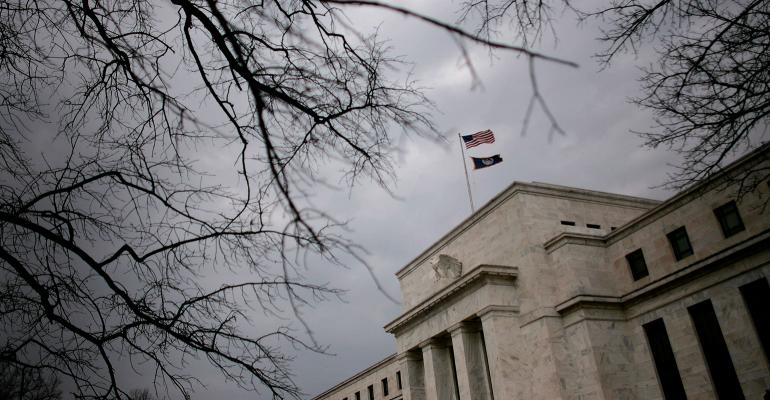By Brian Chappatta
(Bloomberg) --Traders in the $14.2 trillion Treasuries market have found a way to avoid fighting the Federal Reserve, or at least its imminent leadership change.
Whether President Donald Trump nominates Fed Board Governor Jerome Powell, Stanford University economist John Taylor or even Chair Janet Yellen to lead the central bank, one trade is foolproof in the eyes of many on Wall Street: betting on a flatter U.S. yield curve. By most measures, the spread between short- and long-term Treasuries is close to the slimmest in a decade as the Fed raises rates in the face of tame inflation.
To strategists at many of Wall Street’s biggest bond dealers, including BMO Capital Markets, Cantor Fitzgerald and Wells Fargo, no one on Trump’s short list is going to change that momentum. Yellen, considered the most dovish of the group, has already topped market expectations in 2017 by hiking twice and setting up a third increase in December. Traders are pricing in just over two full rate increases by the end of 2018, while the central bank projects four.

“If they’re going to continue on this normalization path -- and whoever comes in is going to do that -- you’re just going to continue to see this flattening yield curve,” said Eric Souza, senior portfolio manager at SVB Asset Management.
Here’s how much the yield curve has flattened since mid-December, when the Fed raised rates for just the second time since the recession. The spread has compressed because shorter-term maturities have underperformed, with two-year yields reaching the highest since 2008.
- From two years to 10 years: Now 83 basis points, down from 135 basis points
- From two years to 30 years: 135 basis points, down from 202 basis points
- From five years to 10 years: 37 basis points, down from 58 basis points
- From five years to 30 years: 90 basis points, down from 127 basis points
The surging two-year yield, in particular, highlights how much traders have had to alter expectations for the Fed, which in 2016 projected four rate hikes but only moved once.
The markets are coming around to the Fed’s projected rate path for 2017. The implied odds that the central bank will boost rates by year-end have jumped to about 83 percent, from 65 percent at the start of the month, based on overnight index swaps and the effective fed funds rate.
Those expectations are also showing up in the futures markets. Hedge funds and other large speculators extended net-short positions on both two- and five-year Treasury futures to a record last week, according to Commodity Futures Trading Commission data through Oct. 17.
“The market has always underpriced a Yellen Fed, and often for good reason, but we see the arguments for continuing to do so limited,” said John Briggs, head of U.S. rates strategy at NatWest Markets. “The risk is for a new Fed to be either similar to the current, more hawkish-than-the-market Fed, or more biased to higher rates.”
Target This Dip
Betting on a flatter curve from two to 10 years is a key trade for NatWest. A core call at Wells Fargo Securities is for a narrowing spread between five- and 10-year notes, said Mike Schumacher, head of rates strategy. Ian Lyngen at BMO Capital Markets called curve steepening “the new dip-to-buy,” with flattening looking like “the path of least resistance.”
To John Herrmann, director of U.S. rates strategy at MUFG Securities Americas, two scenarios can play out depending on the nominee, who is expected to be announced by the end of next week. He’s been advocating a flatter curve from two to 10 years for most of 2017.
- Continuity candidates Powell and Yellen: target 41.1 basis points by the end of 2019
- Taylor or Kevin Warsh, both of whom are perceived as more hawkish: target zero basis points or even a negative spread by the end of 2019

Granted, the more consensus the wager, the greater the pain should it fail. Especially since most yield-curve measures are close to their lowest levels in a decade.
Last week proved just that, with the curve steepening after the Senate narrowly approved a budget vehicle for tax cuts, Trump’s top legislative priority. Should an overhaul become law, long-end yields could lead a selloff on expectations for accelerating U.S. growth and inflation.
The yield curve also steepened Tuesday, with the spread between two- and 30-year Treasuries reaching the highest since Oct. 12.
John R. Taylor, former head of the world’s biggest currency hedge fund, said last week that his analysis of statistical patterns indicates the curve flattening is done.
For now, though, it’s proving tough for the 10-year yield to gain a foothold above 2.4 percent, a key technical level for months. The yield flirted with that mark previously in October, only to retreat, and reached as high as 2.41 percent Tuesday.
“I still favor a curve flattener,” said Justin Lederer, an interest-rate strategist at Cantor Fitzgerald. “Short-term rates are creeping higher from the Fed, and the long end is held in check with inflation running at low levels.”
To contact the reporter on this story: Brian Chappatta in New York at [email protected] To contact the editors responsible for this story: Benjamin Purvis at [email protected] Mark Tannenbaum, Vivien Lou Chen

